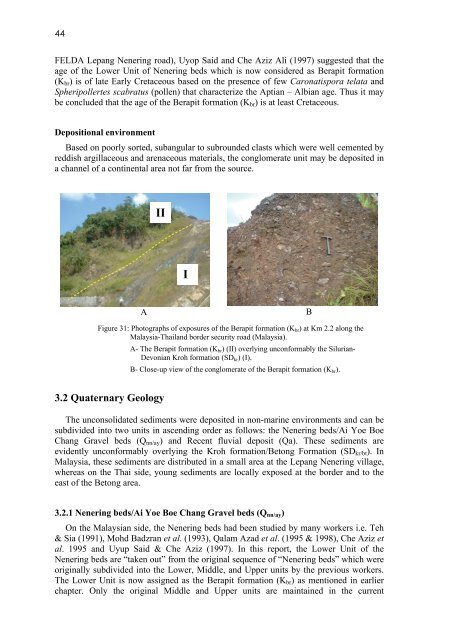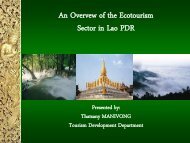GEOLOGY OF THE PENGKALAN HULU-BETONG TRANSECT ...
GEOLOGY OF THE PENGKALAN HULU-BETONG TRANSECT ...
GEOLOGY OF THE PENGKALAN HULU-BETONG TRANSECT ...
You also want an ePaper? Increase the reach of your titles
YUMPU automatically turns print PDFs into web optimized ePapers that Google loves.
44<br />
FELDA Lepang Nenering road), Uyop Said and Che Aziz Ali (1997) suggested that the<br />
age of the Lower Unit of Nenering beds which is now considered as Berapit formation<br />
(Kbr) is of late Early Cretaceous based on the presence of few Caronatispora telata and<br />
Spheripollertes scabratus (pollen) that characterize the Aptian – Albian age. Thus it may<br />
be concluded that the age of the Berapit formation (Kbr) is at least Cretaceous.<br />
Depositional environment<br />
Based on poorly sorted, subangular to subrounded clasts which were well cemented by<br />
reddish argillaceous and arenaceous materials, the conglomerate unit may be deposited in<br />
a channel of a continental area not far from the source.<br />
A<br />
II<br />
Figure 31: Photographs of exposures of the Berapit formation (Kbr) at Km 2.2 along the<br />
Malaysia-Thailand border security road (Malaysia).<br />
A- The Berapit formation (Kbr) (II) overlying unconformably the Silurian-<br />
Devonian Kroh formation (SDkr) (I).<br />
B- Close-up view of the conglomerate of the Berapit formation (Kbr).<br />
3.2 Quaternary Geology<br />
The unconsolidated sediments were deposited in non-marine environments and can be<br />
subdivided into two units in ascending order as follows: the Nenering beds/Ai Yoe Boe<br />
Chang Gravel beds (Qnn/ay) and Recent fluvial deposit (Qa). These sediments are<br />
evidently unconformably overlying the Kroh formation/Betong Formation (SDkr/bt). In<br />
Malaysia, these sediments are distributed in a small area at the Lepang Nenering village,<br />
whereas on the Thai side, young sediments are locally exposed at the border and to the<br />
east of the Betong area.<br />
3.2.1 Nenering beds/Ai Yoe Boe Chang Gravel beds (Qnn/ay)<br />
I<br />
On the Malaysian side, the Nenering beds had been studied by many workers i.e. Teh<br />
& Sia (1991), Mohd Badzran et al. (1993), Qalam Azad et al. (1995 & 1998), Che Aziz et<br />
al. 1995 and Uyup Said & Che Aziz (1997). In this report, the Lower Unit of the<br />
Nenering beds are “taken out” from the original sequence of “Nenering beds” which were<br />
originally subdivided into the Lower, Middle, and Upper units by the previous workers.<br />
The Lower Unit is now assigned as the Berapit formation (Kbr) as mentioned in earlier<br />
chapter. Only the original Middle and Upper units are maintained in the current<br />
B



